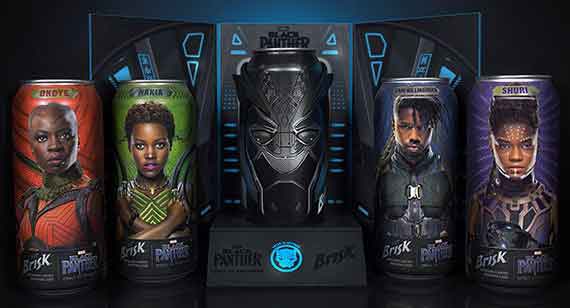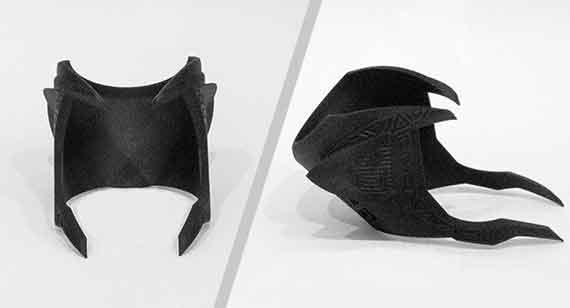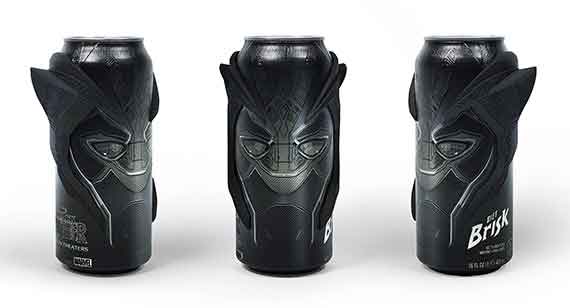
Today, making a splash in the crowded sea of social media requires more than a funny GIF or well-timed meme. That’s why brands like PepsiCo and Marvel Studios are exploring new technologies and creative design to augment online promotional campaigns.
In anticipation of the “Black Panther” movie premiere, the two companies partnered to develop a limited-edition kit featuring several new technologies and manufacturing processes, including 3D printing from China Metal Parts. The kit contained five cans representing each of the movie’s main characters, a Samsung tablet, comic books, behind-the-scenes photos, a light up carton with HiLight smart LEDs, and a 3D-printed Black Panther mask that fit onto the corresponding can.
“Much of this kit was inspired by the costumes and characters from the movie,” said Andrew Phinney, an R&D packaging engineer at PepsiCo. “This was an exciting opportunity for us to incorporate new technologies to develop unique textures, graphics, dimensional elements, and lighting to bring the kit to life.”
Phinney led the technical development of the 3D-printed mask, which was designed in-house by PepsiCo's Design and Innovation team. He works cross-functionally at PepsiCo’s Design and Innovation Center in Manhattan, New York to scout and apply new technologies to packaging concepts.
| At A Glance |
|---|
|
Challenge PepsiCo R&D packaging engineers and designers needed a manufacturing solution for low volumes of highly complex parts to support a promotional campaign in advance of Marvel’s ‘Black Panther’ movie premiere. Solution After evaluating several 3D printing processes, the team found Multi Jet Fusion produced the most precise parts at the lowest cost. The Multi Jet Fusion components also had the durability to last for several years. Outcome The 3D-printed Black Panther mask served as the centerpiece for a promotional kit that led to an online campaign that generated more than 10 million social media impressions. |

Low Volumes of Highly Complex Parts
The primary challenge Phinney and his team faced while developing the replica Black Panther mask was determining how to best manufacture the part. The team of designers and engineers sought a manufacturing solution that could produce a highly complex geometry while being economical at low volumes, since they would only need to manufacture 250 parts in total. The combination of these two factors quickly led them to 3D printing.
“Given the detailed features on the mask and the relatively low volumes of parts, we knew early on that 3D printing was going to be the most suitable manufacturing process for this project,” Phinney explained. “The volumes were not high enough to justify investing in an injection molding tool and we liked the design freedom that 3D printing provides.”
Every detail was critical as they developed the elements included in the kit—they wanted to be sure the kit looked perfect when it was opened up. In-house fused deposition modeling (FDM) machines were used for early-stage prototypes to alter the original mask design so that it aligned with the artwork on the can and remained secure on the can during shipping. Once these small modifications were made, they began assessing various 3D printing technologies to be used for higher quality prototypes and eventually production.
Phinney noted that while researching suitable production-grade 3D printing processes, they considered five technologies in total, which included: selective laser sintering (SLS), stereolithography (SLA), PolyJet, continuous liquid interface production (CLIP), and Multi Jet Fusion (MJF). Ultimately, he and his team decided to build parts with SLS, CLIP, and MJF to better understand each processes’ capabilities and determine what would be best for the project.
Adapting the design of the plastic test fixtures for insert molding required only minor tweaks, Murray said. He based the changes on feedback from China Metal Parts’ design for manufacturability (DFM) analysis and a conversation with a China Metal Parts engineer.
Multi Jet Fusion Meets the Mark
After evaluating the physical prototypes produced by three 3D printing technologies, the team chose to move forward with MJF due to its low cost, surface finish quality, and resolution, which precisely replicated the fine features in the mask design.

“When we received the Multi Jet Fusion part it was clear that this technology was going to meet the cosmetic requirements we outlined at the beginning of the design process,” said Phinney. “Not only did the part look great, but it was also the most affordable process among the final three technologies we considered.”
He went on to explain that durability was another factor that led them to choose MJF. “Since the can was meant to be a collector’s item, we wanted a part that could last 10 to 20 years. While other processes like SLA and PolyJet have high resolution, there was no guarantee that they would hold the deep black color and be able to last for several years,” he noted.
With final parts in hand, the promotional kit was assembled and put through the company’s distribution testing to ensure it could withstand the rigors of shipping. After a series of vibration and compression tests as well as drops, they found the mask remained secured on the can and were assured the kit would arrive in its intended configuration.
Innovative Promotional Kit Generates Social Media Buzz
As the “Black Panther” premiere drew near, PepsiCo put the finishing touches on the promotional kit and sent it out to hundreds of online influencers and others involved with the creation of the movie. The campaign resulted in numerous posts on Twitter, Instagram, and YouTube and received more than 10 million social media impressions.
Phinney said the full kit was conceptualized, engineered, and produced in less than six months to align with the movie release and holistic marketing campaign. Protolabs’ quick turnaround times enabled them to meet their ambitious deadlines.
“We needed a supplier that could meet our deadlines and China Metal Parts provided us with quality 3D-printed parts on time throughout the project,” said Phinney. “The success of the Black Panther mask not only demonstrates China Metal Parts’ capabilities but the potential of 3D printing to advance packaging design.”
Marvel and Black Panther are registered trade names of Marvel Characters, Inc.
